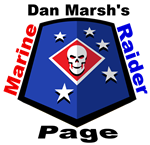The Marine Raiders came into existence to meet the need for special amphibious attack forces similar to the British Commandos. They were organized, equipped, armed and trained to fulfill three primary and several secondary missions.
1) Carry out surprise landings and hard hitting raids on short notice from submarines and destroyers and other transport.
2) Infiltrate enemy lines and conduct guerrilla warfare for extended periods of time.
3) Spearhead major amphibious landings where the approaches were difficult and the beaches confined.
The Raiders were also trained for land and amphibious reconnaissance missions using whatever means of transport available (such as native dug out canoes).
Following Pearl Harbor Japanese Land, Sea and Air forces swept across the Pacific, according to their timetable, overpowering whatever resistance they encountered. The British, Dutch, French and American forces were completely surprised and ill equipped to effectively resist. The subsequent fall of Singapore, considered impregnable by the British, led some military observers to consider the Japanese armed forces to be invincible. The Japanese High Command had the same opinion.
This was generally the situation when the Marine Raider Battalions were activated. The vital statistics are as follows:
- 1st Raider Battalion (designated on Feb. 16, 1942) was commanded by Lt. Col. Merrit A. Edson.
- 2nd Raider Battalion(designated Feb. 19, 1942) was commanded by Lt. Col. Evans F. Carlson.
- 3rd Raider Battalion(designated Sept. 20, 1942) was commanded by Lt. Col. Harry B. Liversedge.
- 4th Marine Raider Battalion(designated Oct. 23, 1942) was commanded by Lt. Col. James Roosevelt, succeeded in May 1943 by Lt. Col. Michael S. Currin.
As each Raider Battalion was organized, they began extended, intensive, and diverse training and were ready to fulfill their missions in the order they were activated. The inflated confidence of the Japanese High Command was soon to be punctured by events at Midway and the Southern Solomon's.
The First Land Counteroffensive
In the early hours of Aug.7, 1942, the First Raider Battalion (Edson’s Raiders) attacked Tulagi as a part of the first amphibious ground counter offensive against the Japanese Empire. Another Marine special unit, the First Parachute Battalion, assaulted Gavutu the same morning. While across Skylark channel the 1st Marine Division was beginning the Battle of Guadalcanal.
[To generate confusion, on Aug. 17-18 two companies of the 2nd Raider Battalion (Carlson’s Raiders) debarked in rubber boats from the submarines Nautilus and Argonaut and slipped ashore on Makin Atoll. Once ashore they systematically eliminated the garrison, destroyed their radio facilities and supplies. The raid distracted the enemy from possible reinforcement of Guadalcanal with troops from that area. Having accomplished their mission they returned to their transport with many delays and difficulties due to high surf.]
On Tulagi Edson’s men found the enemy to be tough and resourceful, but they pressed their attack with great energy and quickly secured the island. After a few days of mopping up the area and reorganizing, the 1st Raiders moved across the channel to Guadalcanal and played a key role in the defense of Henderson Field.
The 1st Raiders and the1st Parachute battalion were deployed in defensive positions across a rolling grassy ridge guarding the approach to Henderson Field. During the nights of Sept. 13-14,heavily out numbered, they withstood continuous, close in assaults against their positions. The fighting was intense, vicious and at close quarters for the duration of the battle. Col. Edson continually moved among his men encouraging them and directing the ebb and flow of the battle. Edson’s men prevailed but their casualties were very heavy. Following the battle many were decorated for heroism including Col. Edson who received the Medal of Honor. The battle has been named in his honor as "The Battle of Edson’s Ridge."
The 1st Raiders continued to play a very significant role in achieving the final victory on Guadalcanal. They participated in the battles of Tasimboko, 1st and 2nd Matanikau River and were finally withdrawn on Oct. 16th to New Caledonia.
Prior to the raid on Makin Island by A and B companies, the units of that Battalion had not been idle. On 21 May, 1942, C and D companies were dispatched to bolster the defense of Midway Island, arriving 25 May. During the battle, D company was stationed on North Island and C company supported the defense of Sand Island. The two companies departed Midway following the battle arriving at Camp Catlin 21 June. Following their return Hq.,A, B, E and F Companies embarked aboard APD’s for amphibious training in the vicinity of Midway. They arrived in the area 26 June and returned to Camp Catlin, when training operations were finished, 4 July, 1942. When A and B companies returned from Makin, the united Battalion departed Pearl Harbor 6 September arriving Espiritu Santo, New Hebridies Islands, 12 September, where they prepared to enter the battle of Guadalcanal. Led by Col. Carlson they landed on a remote beach at Aola Bay and slipped into the jungle. Employing the tactics devised by Col. Carlson they operated for thirty seven days behind the enemy’s lines ambushing Japanese units and destroying his installations and supplies. After inflicting more casualties on the enemy than their numbers they re-entered Marine lines near the Matanikau river. Their highly successful operation became known as The Long Patrol. On 15,Dec.the 2nd Raiders were withdrawn to their base camp on Espiritu Santo.
The victory at Guadalcanal was accomplished through the combined efforts of our land sea and air forces. It is enough to say that the "Battle of Edson's Ridge" and "The Long Patrol" would become legend. As a member of the 4th Raiders I salute them.
